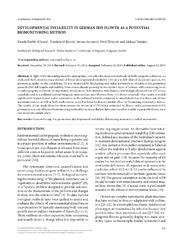Приказ основних података о документу
Developmental instability in German Iris flower as a potential biomonitoring method
| dc.creator | Barišić-Klisarić, Nataša | |
| dc.creator | Miljković, Danijela | |
| dc.creator | Avramov, Stevan | |
| dc.creator | Živković, Uroš | |
| dc.creator | Tarasjev, Aleksej | |
| dc.date.accessioned | 2017-01-12T13:36:54Z | |
| dc.date.available | 2017-01-12T13:36:54Z | |
| dc.date.issued | 2016 | |
| dc.identifier.issn | 0354-4664 | |
| dc.identifier.uri | http://www.doiserbia.nb.rs/img/doi/0354-4664/2016 OnLine-First/0354-46641600072B.pdf | |
| dc.identifier.uri | http://www.serbiosoc.org.rs/arch/index.php/abs/article/view/1257 | |
| dc.identifier.uri | https://radar.ibiss.bg.ac.rs/handle/123456789/2492 | |
| dc.description.abstract | In light of the increasing need for appropriate, cost-effective detection methods of anthropogenic pollution, we evaluated the biomonitoring potential of flower developmental instability (DI) on a widely planted decorative species, Iris germanica, under in situ conditions. DI was measured by fluctuating and radial asymmetries of parts of Iris germanica perianth (810 fall lengths and widths), from clones already growing in two distinct types of habitats with contrasting levels of anthropogenic pollution: in unpolluted (rural) areas, Novi Banovci, Stari Banovci and Belegiš (flowers from 137 clones sampled), and in a polluted (urban) Belgrade metropolitan area (flowers from 133 clones sampled). Our results revealed significantly higher flower radial asymmetry in the polluted habitats compared to unpolluted ones (for three out of four univariate indices, as well as both multivariate ones), but failed to detect a similar effect on fluctuating asymmetry indices. The results of our study therefore demonstrate the potential of DI (when estimated by flower radial asymmetry) in Iris germanica as a cost-effective biomonitoring method for in situ pollution detection based on readily measurable flower parts and moderate sample sizes. | en |
| dc.relation | info:eu-repo/grantAgreement/MESTD/Basic Research (BR or ON)/173025/RS// | |
| dc.rights | openAccess | |
| dc.rights.uri | https://creativecommons.org/licenses/by-nc-nd/4.0/ | |
| dc.source | Archives of Biological Sciences | |
| dc.subject | biomonitoring | |
| dc.subject | Iris germanica | |
| dc.subject | developmental instability | |
| dc.subject | fluctuating asymmetry | |
| dc.subject | radial asymmetry | |
| dc.title | Developmental instability in German Iris flower as a potential biomonitoring method | en |
| dc.type | article | |
| dc.rights.license | BY-NC-ND | |
| dcterms.abstract | Живковић, Урош; Баришић-Клисарић, Наташа; Миљковић, Данијела; Тарасјев, Aлексеј; Aврамов, Стеван; | |
| dc.rights.holder | © 2016 the Serbian Biological Society | |
| dc.citation.issue | 4 | |
| dc.citation.volume | 68 | |
| dc.description.other | Archives of Biological Sciences (2016), 68(4): 837-844 | |
| dc.identifier.doi | 10.2298/ABS151229072B | |
| dc.identifier.scopus | 2-s2.0-85002572683 | |
| dc.identifier.wos | 000389771500016 | |
| dc.citation.apa | Barišić-Klisarić, N., Miljković, D., Avramov, S., Živković, U., & Tarasjev, A. (2016). Developmental instability in German Iris flower as a potential biomonitoring method. Archives of Biological Sciences, 68(4), 837–844. | |
| dc.citation.vancouver | Barišić-Klisarić N, Miljković D, Avramov S, Živković U, Tarasjev A. Developmental instability in German Iris flower as a potential biomonitoring method. Arch Biol Sci. 2016;68(4):837–44. | |
| dc.citation.spage | 837 | |
| dc.citation.epage | 844 | |
| dc.type.version | publishedVersion | en |
| dc.identifier.fulltext | https://radar.ibiss.bg.ac.rs//bitstream/id/3423/ArchBiolSci_2016_68_4_837-844.pdf | |
| dc.citation.rank | M23 |

